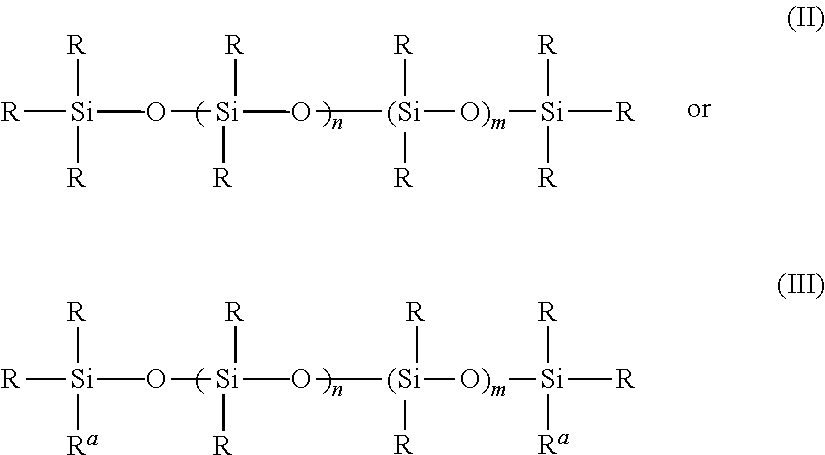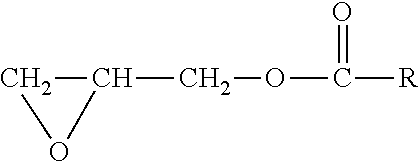Curable film-forming compositions demonstrating burnish resistance and low gloss, and methods of improving burnish resistance of a substrate
a technology of burnish resistance and burnish resistance, applied in the direction of liquid surface applicators, polyurea/polyurethane coatings, coatings, etc., can solve the problems of poor mar resistance, entail significant loss of coating materials, and affect so as to improve the burnish resistance of substrates
- Summary
- Abstract
- Description
- Claims
- Application Information
AI Technical Summary
Benefits of technology
Problems solved by technology
Method used
Image
Examples
example a
[0107]This example describes the preparation of polysiloxane polyol, a product of the hydrosilylation of pentasiloxane with an approximate degree of polymerization of 3 to 4, i.e., (Si—O)3 to (Si—O)4. The polysiloxane polyol was prepared from the following mixture of ingredients:
Equiva-Parts BylentEquiva-WeightIngredientsWeightlents(kilograms)Charge I:Trimethylolpropane monoallyl ether174.0756.0131.54Charge II:MASILWAX BASE1156.72594.893.21Charge III:Chloroplatinic acid10 ppmToluene0.23Isopropanol0.071Polysiloxane-containing silicon hydride, commercially available from BASF Corporation.2Equivalent weight based on mercuric bichloride determination.
[0108]To a suitable reaction vessel equipped with a means for maintaining a nitrogen blanket, Charge I and an amount of sodium bicarbonate equivalent to 20 to 25 ppm of total monomer solids was added at ambient conditions and the temperature was gradually increased to 75° C. under a nitrogen blanket. At that temperature, 5.0% of Charge II w...
example b
[0109]This example describes the preparation of a protonated silica dispersion in a polysiloxane. 25 g of ACEMATT TS100 (available from Evonik Industries AG) was mixed with 250 g of methanol in a four-neck round bottom flask equipped with a mechanical stirrer. While stirring, HCl acid was added until the viscosity of the mixture was markedly reduced and the pH was less than 1. After stirring for one hour the mixture was filtered using a Buchner funnel, rinsed with methanol and then allowed to dry at 120° F. overnight. The protonated silica was then mixed with 256 g methanol and stirred for 30 min in a four-neck round bottom flask equipped with a mechanical stirrer, temperature probe, reflux condenser, addition funnel, vacuum outlet and a nitrogen inlet. Then the 144 g of the polysiloxane polyol, as described above, was added to the methanol / silica mixture. Upon completion of the polysiloxane addition 163.38 g of methyl isobutyl ketone was added and the entire mixture was stirred for...
example 1
[0111]
IngredientWeight (g)A-PackEVERSORB 7410.45EVERSORB 93L10.6BYK 30020.2ADDITOL VXL 493030.06Dibutyl tin dilaurate0.02D871410.0Acrylic Polyol 153.82Acrylic Polyol 262.20Siloxane / silica dispersion724.0B-PackDESMODUR N-3600813.71Available from Everlight Chemical Industrial Corp.2Available from Byk Chemie3Available from Cytec Industries Inc.4Solvent blend available from PPG Industries, Inc.5Solventborne acrylic polyol consisting of styrene, hydroxypropyl acrylate, isostearic acid, glycidyl methacrylate, and methyl methacrylate6Solventborne acrylic polyol consisting of hydroxypropyl methacrylate, methyl methacrylate, n-butyl methacrylate, styrene, Cardura E / acrylic acid adduct, and acrylic acid7As described above in Example B8Available from Bayer MaterialScience
[0112]The film forming composition of Example 1 was spray applied to a pigmented basecoat to form color-plus-clear composite coatings over primed electrocoated steel panels. The panels used were ACT cold roll steel panels (10....
PUM
| Property | Measurement | Unit |
|---|---|---|
| particle size | aaaaa | aaaaa |
| 85° gloss | aaaaa | aaaaa |
| 85° gloss | aaaaa | aaaaa |
Abstract
Description
Claims
Application Information
 Login to View More
Login to View More - R&D
- Intellectual Property
- Life Sciences
- Materials
- Tech Scout
- Unparalleled Data Quality
- Higher Quality Content
- 60% Fewer Hallucinations
Browse by: Latest US Patents, China's latest patents, Technical Efficacy Thesaurus, Application Domain, Technology Topic, Popular Technical Reports.
© 2025 PatSnap. All rights reserved.Legal|Privacy policy|Modern Slavery Act Transparency Statement|Sitemap|About US| Contact US: help@patsnap.com



